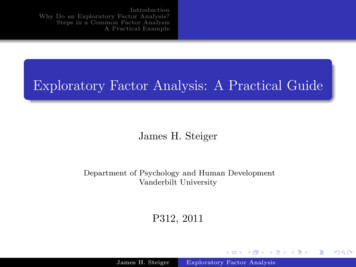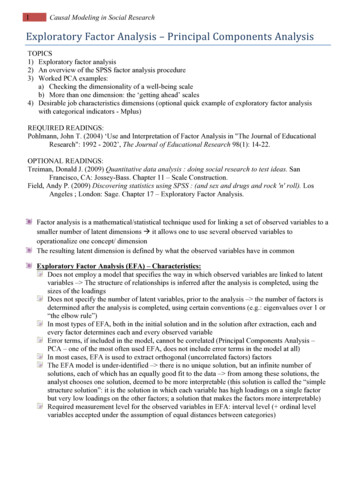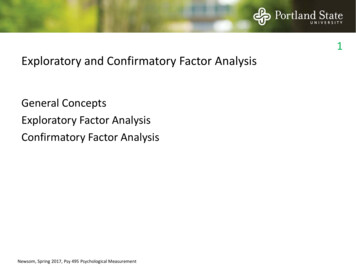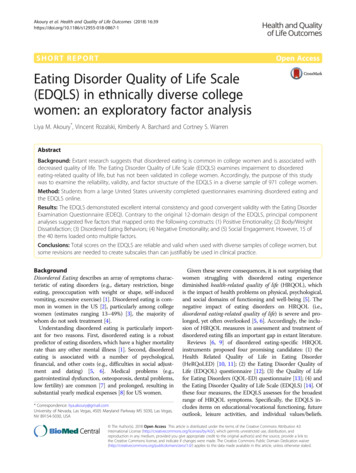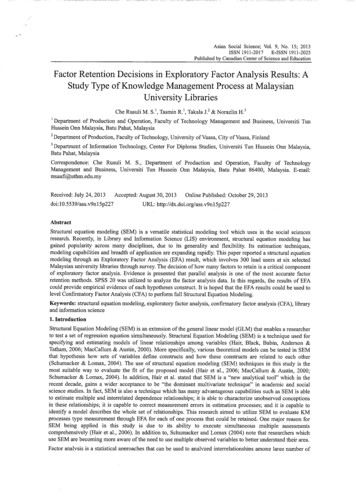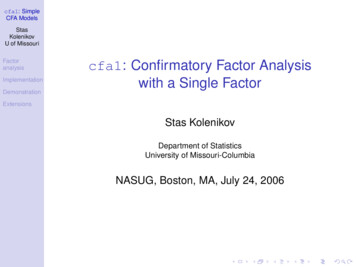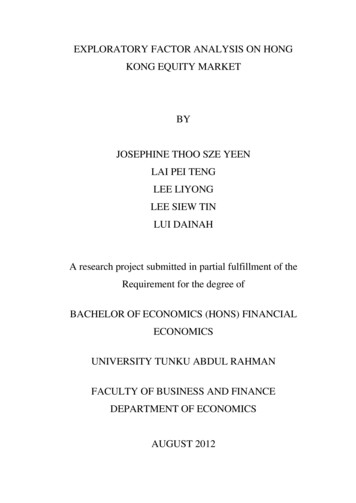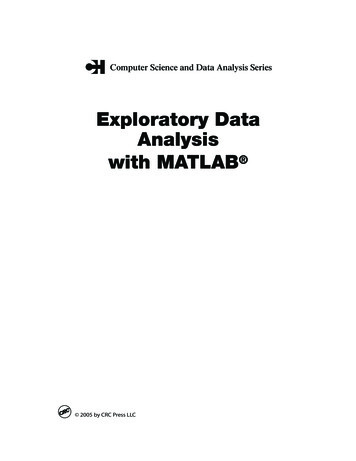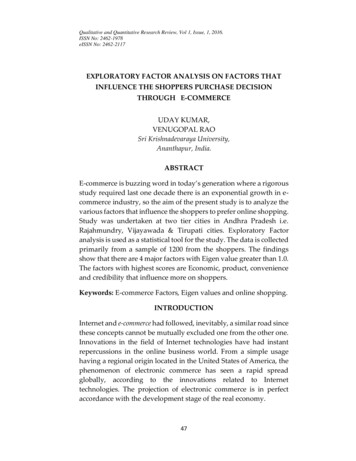
Transcription
Qualitative and Quantitative Research Review, Vol 1, Issue, 1, 2016.ISSN No: 2462-1978eISSN No: 2462-2117EXPLORATORY FACTOR ANALYSIS ON FACTORS THATINFLUENCE THE SHOPPERS PURCHASE DECISIONTHROUGH E-COMMERCEUDAY KUMAR,VENUGOPAL RAOSri Krishnadevaraya University,Ananthapur, India.ABSTRACTE-commerce is buzzing word in today’s generation where a rigorousstudy required last one decade there is an exponential growth in ecommerce industry, so the aim of the present study is to analyze thevarious factors that influence the shoppers to prefer online shopping.Study was undertaken at two tier cities in Andhra Pradesh i.e.Rajahmundry, Vijayawada & Tirupati cities. Exploratory Factoranalysis is used as a statistical tool for the study. The data is collectedprimarily from a sample of 1200 from the shoppers. The findingsshow that there are 4 major factors with Eigen value greater than 1.0.The factors with highest scores are Economic, product, convenienceand credibility that influence more on shoppers.Keywords: E-commerce Factors, Eigen values and online shopping.INTRODUCTIONInternet and e-commerce had followed, inevitably, a similar road sincethese concepts cannot be mutually excluded one from the other one.Innovations in the field of Internet technologies have had instantrepercussions in the online business world. From a simple usagehaving a regional origin located in the United States of America, thephenomenon of electronic commerce has seen a rapid spreadglobally, according to the innovations related to Internettechnologies. The projection of electronic commerce is in perfectaccordance with the development stage of the real economy.47
Qualitative and Quantitative Research Review, Vol 1, Issue, 1, 2016.ISSN No: 2462-1978eISSN No: 2462-2117REVIEW OF LITERATUREDefinition of e-commerceAccording to IBM, which has defined this concept in 1997, “e-businesscan be the key in transforming business processes using Internettechnologies.'' Analyzed from a general perspective, e-business maygather under its umbrella three major components: The human dimension that includes processes and activitiesrelated to research, development, marketing, manufacturing,logistics, management, etc.The technological-only component, akin to informationrelated technologies.Commercial or e-commerce component, taken as a whole andperceived primarily as a phenomenon – having a differentmeaning that the term known e-commerce, basically thepurchase of goods and services through Internet technologies.Electronic commerce (e-commerce) is the buying and selling,marketing of products and services, and providing information viacomputer networks (O'Brien & maracas, 2006). Many companies arenow engaged in or sponsor three basic categories of e-commerceapplications, i.e., e-commerce business-to-consumer, business-tobusiness, and consumer-to-consumer (O'Brien, 2005). Lee et al.(2011) conducted a study in Malaysia in 2010; the instrument usedwas questionnaire survey using seven Likert scale. Data collectionmethod used was a snowball effect for 102 respondents. Throughregression and correlation analysis, it was found that perceivedvalue, perceived ease of use, perceived usefulness, firm's reputation,privacy, trust, reliability and functionality have a significant linearrelationship to online repurchase intentions. Delafrooz et al. (2011)who conducted a study in Malaysia with 370 respondents obtainedfrom a private university in Selangor by using path analysis foundthat the trust and consumer attitudes have the strongest direct effecton buying online intention. While the utilitarian orientation,convenience, price, broader product selection, and earnings havealso strong indirect effect on online shopping intentions through48
Qualitative and Quantitative Research Review, Vol 1, Issue, 1, 2016.ISSN No: 2462-1978eISSN No: 2462-2117attitudes toward online shopping as mediation. Kwek et al. (2010)conducted a study of 242 respondents in Malaysia by using multipleregression analysis and found that impulse buying intentions,consumer orientation to quality, customer orientation to brands,online trust and online purchasing experience is positively related toprior purchase intention of online customers. Shergill & Chen (2005)collected data by conducting surveys via e-mail randomly to 102respondents in New Zealand. Then, using exploratory factoranalysis and ANOVA found that the site design, site reliability,customer service sites, and site safety are the four dominant factorsthat influence consumer perceptions of online purchases.Objectives of the study1. To study the various factors that influences the shoppers toopt for online shopping.2. To examine the relationship among the variables those arewithin the factors by using exploratory factor analysis.RESEARCH METHODOLOGYSample sizeThe researcher selected online shoppers in the cities ofRajahmundry, Vijayawada and Tirupati as a sample for the study.Table No 1.Sample distributionName of the cityNo. of frequent buyersthrough onlineSample 27416Total:Source: compiled from websites (2014)491200
Qualitative and Quantitative Research Review, Vol 1, Issue, 1, 2016.ISSN No: 2462-1978eISSN No: 2462-2117Frequently buying people are taken as respondents. Convenientsampling method has been adopted for data collection.DATA COLLECTIONBoth primary and secondary data has been collected for the purposeof the study. The survey method has been used to gather primaryinformation for the study. The required data has been collected fromthe sample respondents with the structured questionnaire designedfor the purpose. The secondary data has been collected throughbooks, journals, magazines, internet, articles related for the study.Questionnaire:Based on the objective of the study, close ended questionnaire isprepared. Likert Scale method has been used, respondents havebeen asked to state their level of agreement or disagreement on 5point scale where 5 strongly agree; 4 agree; 3 neutral; 2 disagree;1 strongly disagree.HypothesisH0: There is no significant relationship among variables in factorsH1: There is a significant relationship among variables in factorsData AnalysisExploratory factor analysis is used with the help of SPSS-22RESULTS AND DISCUSSIONThe researcher has applied the exploratory factor analysis to studythe various observed variables that influence the shoppers to opt foronline shopping. There are 16 variables are considered for the studyand 4 major factors was extracted from the study. The followingfigure-4.1 shows the 4 factors of the study.50
Qualitative and Quantitative Research Review, Vol 1, Issue, 1, 2016.ISSN No: 2462-1978eISSN No: 2462-2117EconomicConvenienceFactors’ influencing theshopper’s to opt onlineshopping.CredibilityProductFigure 1.Factors shoppers to opt for online shoppingTable No 2 Reliability AnalysisReliability StatisticsCronbach's Alpha.837N of Items16The first step in exploratory factor analysis is to check the reliabilityof the observed variables, the reliability of the data will be checkedby using Cronbachs alpha. Table 1 shows the value of 0.837 asCronbachs alpha for 16 variables. The cutoff point of cronbach alphais 0.7, where 0.837 is very much greater than cut off rate, therefore allthe sixteen variables are reliable to carry out with exploratory factoranalysis.Table No 3. Testing of hypothesisKMO and Bartlett's TestKaiser-Meyer-Olkin Measure of Sampling Adequacy.Bartlett's Test ofSphericityApprox. Chi-SquaredfSig.51.82530842.350120.000
Qualitative and Quantitative Research Review, Vol 1, Issue, 1, 2016.ISSN No: 2462-1978eISSN No: 2462-2117RESULTSKMO and Bartlett’s Test is established in order to know the strengthof the factor analysis solution and to test the hypothesis. The abovetable 3 gives the results that KMO measure of sampling adequacy is.825 which is greater than cut off rate 0.7, indicating that factoranalysis could be used for the given set of data. Further, Bartlett’stest of sphericity used to test the hypothesis, where the p value is0.000, which is less than significant value 0.05, where there is noproper evidence to accept the null hypothesis; therefore there is asignificant relationship among variables in factors.Table No 4 Factor loadingsSl.NoDimensionsVariables 1.Economic 2.Product I shop online becauseof the cheaper price.I can compare price inonline shopping.Discounts are high inonline shopping.Freedeliveryinfluences me to go foronline shopping.Competitivepriceavailability compareto solid shops.To buy limited editionproducts Ipreferonline shopping.Ipreferonlineshopping due to wideproducts availability.Ipreferonlineshopping due to 50.906
Qualitative and Quantitative Research Review, Vol 1, Issue, 1, 2016.ISSN No: 2462-1978eISSN No: 2462-2117 3Convenience 4Credibility availabilityofproducts in solidshops.Ipreferonlineshopping for sensitiveproducts.Ipreferonlineshopping as I can doeven during officetime.24/7conveniencemake me to preferonline shopping.Easy return policymakes me to preferonline shopping.I can sell or buysecond hand goodsthrough online.While shopping onlineI can see the ratingsand prefer products.Online feedback fromthe existing usersincreases my trust topreferonlineshopping.Online rating is preauthentication to thequality 390.851
Qualitative and Quantitative Research Review, Vol 1, Issue, 1, 2016.ISSN No: 2462-1978eISSN No: 2462-2117InferenceTable 4 presents factor matrix (component matrix). The resultincludes the correlation coefficient between the relevant factor scorewith the original standardized variables. The correlation coefficientbetween the factor score and the variables included in the study iscalled factor loadings which are presented in the above table. Thefactor loadings are used to compute Eigen values for each factor.Factor 1: Economic factorThe variables like, I shop online because of the cheaper price, I cancompare price in online shopping, Discounts are high in onlineshopping, Free delivery influences me to go for online shopping,Competitive price availability compare to solid shops analysis, ishaving the higher factor loadings and grouped under onecomponent. Hence all the observed variables are related to monetarybenefits, the researcher named this factor as economic factor and itis observed that it is the major factor that influence the shoppers toopt online shopping.Factor 2: ProductThe variables like, To buy limited edition products I prefer onlineshopping, I prefer online shopping due to wide productsavailability, I prefer online shopping due to non-availability ofproducts in solid shops, I prefer online shopping for sensitiveproducts, all the above variables are related to tangible productbased where grouped under one component, therefore researchernamed the component as product factor. It is observed another majorfactor that influences the shoppers.Factor 3: ConvinenceThe variables like, I prefer online shopping as I can do even duringoffice time, 24/7 convenience make me to prefer online shopping,Easy return policy makes me to prefer online shopping, I can sell orbuy second hand goods through online. All the said variables aregrouped under one component where they are highly correlated andall the variables are related to convenient of shoppers; therefore it54
Qualitative and Quantitative Research Review, Vol 1, Issue, 1, 2016.ISSN No: 2462-1978eISSN No: 2462-2117was labeled as convenience factor. This is also a major factor thatinfluences the shopper preference for online shopping.Factor 4: CredibilityVariables like, while shopping online I can see the ratings and preferproducts, online feedback from the existing users increases my trustto prefer online shopping, online rating is pre authentication to thequality assurance, all the variables are grouped under onecomponent where all the said variables are related to trustworthiness of the shoppers, therefore researcher labeled as acredibility factor, it is found that credibility also place an importantrole that influence the shoppers to opt for online shopping.Table No 5. Total Variance n Sums ofRotation Sums ofInitial Eigen valuesSquared LoadingsSquared Loadings% of% of Cumul% ofVaria CumulatVarian ativeVarian CumulaTotalnceive % Totalce%Totalcetive %6.319 39.4939.491 6.31 39.49 39.491 5.053 31.5831.5833.725 23.2862.773 3.72 23.28 62.773 3.387 21.1752.7552.890 18.0680.834 2.89 18.06 80.834 3.304 20.6473.4041.567 9.79490.628 1.56 9.794 90.628 2.756 17.2290.628.343 2.14792.775.277 1.72994.503.213 1.33095.834.186 09899.922.013.078 100.000Extraction Method: Principal Component Analysis.Table 5 gives the output of total variance. The table explains the totalvariance contributed by each component. We can see that thepercentage of total variance contributed by first component is 39.491,55
Qualitative and Quantitative Research Review, Vol 1, Issue, 1, 2016.ISSN No: 2462-1978eISSN No: 2462-2117second component is 23.282, third component is 18.061 and fourthcomponent is 9.784. From the above table it is also clear that thereare total 4 distinct components for the given set of 16 observedvariables.Scree PlotThe scree plot gives the number of components against the Eigenvalues and helps to determine the optimal number of components.The components having steep slope indicates that good percentageof total variance is explained by that component, hence thecomponent is justified. The following scree plot, the first 4components have steep slope that is they are greater than one andlater the slope is shallow that is less than one. This indicates the idealnumber of components is 4.Figure 2.Optimal number of components56
Qualitative and Quantitative Research Review, Vol 1, Issue, 1, 2016.ISSN No: 2462-1978eISSN No: 2462-2117Table No 6. Summary of results of factor analysisFactorsPrice Product Convenience Credibility I shop online because ofthe cheaper price.I can compare price inonline shopping.I prefer online shoppingas I can do even duringoffice time.To buy limited editionproducts I prefer onlineshopping.I prefer online shoppingdue to wide productsavailability.I prefer online shoppingdue to non-availability ofproducts in solid shops.Discounts are high inonline shopping.While shopping online Ican see the ratings andprefer products.Online feedback from theexisting users increasesmy trust to prefer onlineshopping.Free delivery influencesme to go for onlineshopping.24/7 convenience makeme to prefer onlineshopping.Competitive priceavailability in compare tosolid shops.I prefer online shoppingfor sensitive products.Easy return policy makesme to prefer .954.934.962.880.89657
Qualitative and Quantitative Research Review, Vol 1, Issue, 1, 2016.ISSN No: 2462-1978eISSN No: 2462-2117 Online rating is preauthentication to thequality assurance. I can sell or buysecondhand goodsthrough online.Extraction Method: Principal Component Analysis.Rotation Method: Varimax with Kaiser Normalization.a. Rotation converged in 5 iterations.883.893The above table 6 gives the summary of the results of the factoranalysis. The items deleted indicate that they do not come under anyof the component factors.CONCLUSIONFrom the above discussion it can be inferred that major four factorshave huge impact on shoppers online purchase decision, it clearlyobserved that five variables are observed by economic factor, fourvariables are observed by product related factors, four othervariables are observed by convenience factor and three variables areobserved by credibility factor.REFERENCEDelafrooz, N., Paim, L.H., & Khatibi, A. (2011). Understandingconsumer’s internet Purchase intention in Malaysia. AfricanJournal of Business Management, 5(3), 2837-2846.Kwek, C.L., Tan, H.P., & Lau, T. C. (2010). The Effects of ShoppingOrientations, Online Trust and Prior Online PurchaseExperience toward Customer’s Online Purchase Intention.International Business Research, 3(3). 63-76.Lee, C.H., Eze, U.C., & Ndubisi, N.O. (2011). Analyzing keydeterminants of online repurchase intentions. Asia PacificJournal of Marketing and, 23(2), 200-221.O'Brien, J. A. (2005). Introduction to Information Systems. 12th Edition.New York: McGraw Hill.58
Qualitative and Quantitative Research Review, Vol 1, Issue, 1, 2016.ISSN No: 2462-1978eISSN No: 2462-2117O'Brien, J.A., & Marakas, G.M. (2006). Management InformationSystems. 7th Edition. New York: McGraw Hill.Schiffman, L.G., Sherman, E., & Long, M.M. (2003). Toward a betterunderstanding of the interplay of personal values and theInternet. Psychology & Marketing, 20(2), 169-186, 2003.Shergill, G.S., & Chen, Z. (2005). Web-based Shopping: Consumers’Attitudes towards Online Shopping in New Zealand. Journal ofElectronic Commerce Research, 6(2), 79-94.Shergill, G., & Chen, Z., (2005). Web Based Shopping: Consumers’Attitude towards Online Shopping in NewZealand, Journal ofElectronic Research, 6(2), 79-94. [Online] Available:http://commerce.massey.ac.nz/research outputs/2003/2003008.pdf.Solomon, M.R. (1998). Consumer behavior. New York, NY: PrenticeHall.Sorce, P., Perotti, V., & Widrick, S. (2005). Attitude and agedifferences in online buying, International Journal of Retail &Distribution Management, 33, (2/3), 122-132, 2005.Sultan, F., & Henrichs, R.B. (2000). Consumer preferences forInternet services over time: initial explorations. The Journal ofConsumer Marketing, 17(5), 386-403, 2000.59
Exploratory factor analysis is used with the help of SPSS-22 RESULTS AND DISCUSSION . The first step in exploratory factor analysis is to check the reliability of the observed variables, the reliability of the data will be checked by using Cronbachs alpha. Table 1 shows the value of 0.837 as
